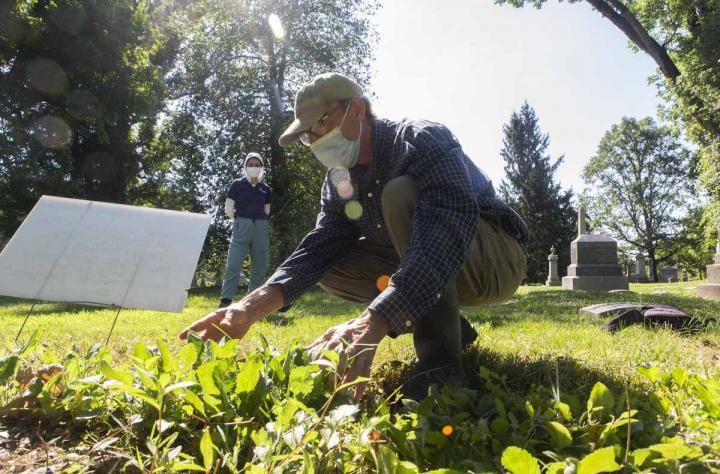E. Lucy Braun was a pioneering scientist and conservationist

Credit: Joseph Fuqua II/UC Creative + Brand
A University of Cincinnati biologist helped organize a fitting tribute to one of America’s legendary conservationists and botanists, E. Lucy Braun.
Denis Conover, a professor of biology in UC’s College of Arts and Sciences, collaborated with Cincinnati’s Spring Grove Cemetery and Arboretum to replace the nonnative plants adorning her grave with native ones found in the eastern United States.?
No doubt, Braun would have approved.
“Lucy Braun was a great botanist, plant ecologist and conservationist,” Conover said. “For years I thought it was too bad that she had English ivy, a nonnative and invasive species, growing on her grave. I thought how nice it would be if they could replace it with native plants.”
Conover and David Gressley, the cemetery’s director of horticulture, carefully selected a mix of native ground cover that would be suitable for her plot, which sits in the shade of a holly tree near one of Ohio’s oldest and most impressive white oak trees. Instead of English ivy, which can spread like a blanket across the forest floor, they chose a mix of creeping mint, golden star and Allegheny spurge, all flowering plants that are native to deciduous forests in Eastern North America.
Conover wrote about the living tribute in the journal Ecological Restoration.
Spring Grove ended its practice of introducing nonnative ground cover on new cemetery plots in the late 1990s, Gressley said.
“The evergreen ground cover signifies everlasting life, which was the intent when it was planted,” he said.
Today, the cemetery experiments with native plants for that purpose, he said. The tribute to Braun was overdue, he said.
“She was a pioneer. She gave definition to what today is known as the field botanist,” he said. “Her work remains extremely influential. People have built on her work, but she provided the foundation.”
Braun wrote about invasive species such as Amur honeysuckle, imported as an ornamental shrub from Asia, in her 1961 book “The Woody Plants of Ohio.” It was just beginning to show up in Hamilton County. Today, it’s the bane of foresters and backyard gardeners all over Ohio and other parts of Eastern North America.
Braun (1889-1971) was a pioneer in so many ways. Author of 180 published articles and reference books, she was the first female president of the Ecological Society of America. Her masterwork, “Deciduous Forests of Eastern North America,” was hugely influential in the study of plant ecology, Conover said.
She inspired generations of students at UC to pursue science careers, including Margaret H. Fulford, namesake of UC’s herbarium.
But it wasn’t enough for her to study the region’s flora. She wanted to save it. She led the effort to preserve the biologically rich habitats of southern Ohio, now known as the Edge of Appalachia Nature Preserve. At the time of her death, she was fighting to protect Red River Gorge from a proposed federal dam. The conservation effort was successful.
###
Media Contact
Michael Miller
[email protected]
Original Source
https:/
Related Journal Article
http://dx.




